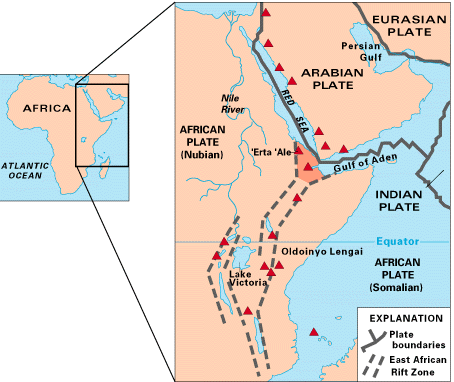Theory of Plate Tectonics
Key Questions
-
Answer:
The main differences are the thickness and nature of the crust in oceanic and continental plates.
Explanation:
oceanic plates are formed at divergent boundaries mainly at mid ocean ridges. The material that is poured out are basaltic lave in nature. Basalt is denser and heavier than the granite that makes up continental plates.
Oceanic plates are much thinner than the continental plates. When an oceanic plate meets a continental plate at a convergent boundary the oceanic plate is forced under the continental plate and destroyed. The convergent boundaries between ocean and continental plates create subduction zones. The oceanic plate is pushed under the continental plate and melted. This melted material becomes magma that may reach the surface as volcanos, or solidify under the surface as granite.
Continental plates are much thicker that Oceanic plates. At the convergent boundaries the continental plates are pushed upward and gain thickness. The rocks and geological layers are much older on continental plates than in the oceanic plates. The Continental plates are much less dense than the Oceanic plates. The Granite and recycled material are much lighter than the heavy basalt layers of the ocean plates.
-
Answer:
The main plate boundaries are convergent, divergent, and transform.
Explanation:
- A convergent boundary happens when two plates are moving towards each other: one plate is subducted below another or mountains are formed.
- A divergent boundary happens when two plates are moving away from each other.
- A transform boundary happens when two plates move away from a divergent plate boundary.
India and Asia collided on two different plates a very long time ago and the Himalaya Mountains were formed (and are still growing as the two plates continue to collide). This is an example of a convergent boundary.
An excellent example of a transform boundary is the San Andreas Fault. Check out this site for more information on transform faults and an animation of the San Andreas Fault.
If you look at a map of Africa, you can see an example of a divergent boundary on land where two plates are moving away from each other. The Arabian Plate is splitting or moving away from mainland Africa due to a mid-ocean ridge between the two where new oceanic crust forms.

-
Theory of Plate Tectonics was established by Alfred Wegener. Fossils and Mountain ranges were his evidences.
Alfred Wegener created the idea of continental drift and wrote 'The Origin of Continents and Oceans' to support his idea. His theory was rejected by geologists at first. His ideas have been scientifically proven as time goes on.
Wegener gave examples in both plant and animal fossils, mountain ranges to support his idea.
Appalachian Mountains are situated from West to East in North America and be interrupted at New Foundland in the East coast of North America. Another mountain range starts in Greenland and go along in Ireland, UK and Norway with the similar stratification.
Fossils are the stongest evidences of plate tectonics. Same plant fossils can be seen in distant continents such as South America and Africa. One can say that it is because of the birds and wind. They might be carried seeds across oceans. It maybe a logical objection to Wegener's theory but could giant dinosaurs swim entire the ocean? They obviously could not. Fossil of the same dinosaur can be seen in South America, Africa, India and Antartica. Only reasonable explanation of that is once all this continents were together. This continent is called Gondwana. These evidences are some of strong evidences of plate tectonics.